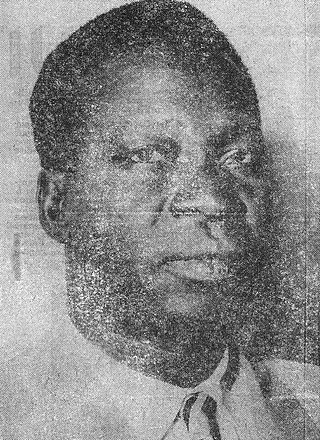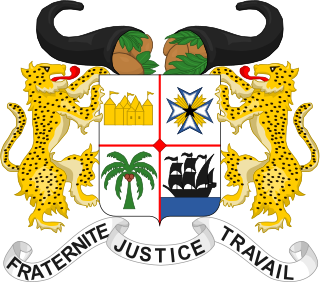
The Kingdom of Dahomey was a West African kingdom located within present-day Benin that existed from approximately 1600 until 1904. It developed on the Abomey Plateau amongst the Fon people in the early 17th century and became a regional power in the 18th century by expanding south to conquer key cities like Whydah belonging to the Kingdom of Whydah on the Atlantic coast which granted it unhindered access to the Triangular trade.
The History of Benin since the 16th century, for the geographical area included in 1960 in what was then called the Republic of Dahomey before becoming the People's Republic of Benin.

French West Africa was a federation of eight French colonial territories in West Africa: Mauritania, Senegal, French Sudan, French Guinea, Ivory Coast, Upper Volta, Dahomey and Niger. The federation existed from 1895 until 1958. Its capital was Saint-Louis in Senegal until 1902, and then Dakar until the federation's collapse in 1960.

The national flag of Benin is a flag consisting of two horizontal yellow and red bands on the fly side and a green vertical band at the hoist. Adopted in 1959 to replace the French Tricolour, it was the flag of the Republic of Dahomey until 1975, when the People's Republic of Benin was established. The new regime renamed the country and changed the flag to a green field with a red star in the canton. This version was utilized until multi-party democracy was re-established in 1990, coinciding with the Revolutions of 1989. The new government promptly restored the original pre-1975 flag.

Émile Derlin Zinsou was a Beninese politician and physician who was the President of Dahomey from 17 July 1968 until 10 December 1969, supported by the military regime that took power in 1967. Zinsou was present at the signing of the treaty that formed the African Union on 12 July 2000 in Togo.

Sourou-Migan Marcellin Joseph Apithy was a Beninese political figure most active when his country was known as Dahomey. He arose on a political scene where one's power was dictated by what region in Dahomey one lived in.

Coutoucou Hubert Maga was a politician from Dahomey. He arose on a political scene where one's power was dictated by what region in Dahomey one lived in. Born a peasant in 1916, Maga served as a schoolmaster from 1936 to 1945, during which time he gradually gained considerable influence among the uneducated. He was elected to Dahomey's territorial assembly in 1947 and founded the Northern Ethnical Group, later renamed the Dahomey Democratic Rally. In 1951, Maga was elected to the French National Assembly, where he served in various positions, including premier from 1959 to 1960. When Dahomey gained its independence from France on August 1, 1960, Maga was appointed to the presidency, and was officially elected to that post on December 11.

Justin Ahomadegbé-Tomêtin was a Beninese politician most active when his country was known as Dahomey. He arose on a political scene where one's power was dictated by what region of Dahomey one lived in. He served as president of the National Assembly of Dahomey from April 1959 to November 1960 and as prime minister and vice president of Dahomey from 1964 to 1965.

Elections in Benin take place within the framework of a multi-party democracy and a presidential system. Both the President and the National Assembly are directly elected by voters, with elections organised by the Autonomous National Electoral Commission (CENA).

The Communist Party of Benin is an anti-revisionist Marxist–Leninist communist party in Benin. PCB was founded in 1977 by the Union of Communists of Dahomey. The party was initially called Communist Party of Dahomey. The first secretary of the party is Philippe Noudjenoume. PCB publishes La Flamme.

French Dahomey, officially the Colony of Dahomey and Dependencies, was a French colony and part of French West Africa from 1894 to 1958. After World War II, by the establishment of the French Fourth Republic in 1947, Dahomey became part of the French Union with increased autonomy. On 4 October 1958 the French Fifth Republic was established, and the French Union became the French Community. The colony became the self-governing Republic of Dahomey within the Community, and two years later on 1 August 1960, it gained full independence, renamed to Benin in 1975.
The 1963 Dahomeyan coup d'état was staged on October 28, 1963, by Christophe Soglo, who took control of the Republic of Dahomey to prevent a civil war. He overthrew Hubert Maga, whose presidency faced extreme economic stagnation and a host of other problems.
Paul Darboux was a Beninese merchant and politician, most active when his country was known as Dahomey.

Elections for the Territorial Assembly were held in French Dahomey on 30 March 1952. Sourou-Migan Apithy's Republican Party of Dahomey won 19 of the 32 second college seats. Only ten members of the Legislative Council elected in 1947 were re-elected.

Elections to the French National Assembly were held in French Dahomey on 17 June 1951. The territory elected two seats to the Assembly, which were won by Sourou-Migan Apithy of the List of the French Union and Hubert Maga of the Ethnic Group of the North. Voter turnout was 44%.

Elections to the French National Assembly were held in French Dahomey and French Togoland on 21 October 1945. The territory elected two seats to the Assembly via two electoral colleges. French missionary Francis Aupiais of the Popular Republican Movement was elected from the first college and Sourou-Migan Apithy in the second, but Aupiais died before taking office.

Elections to the French National Assembly were held in French Dahomey and French Togoland on 2 June 1946. The territory elected two seats to the Assembly via two electoral colleges. Pierre Bertho of the Popular Republican Movement was elected from the first college and Sourou-Migan Apithy in the second.

Elections to the Territorial Assembly were held in French Dahomey on 31 March 1957. The result was a victory for the Republican Party of Dahomey, which won 35 of the 60 seats.

The 1972 Dahomeyan coup d'état was a military coup staged on 26 October 1972 by Major Mathieu Kérékou, who took control of the Republic of Dahomey and ended a system of government established following the annulled 1970 presidential election, in which three members of the Presidential Council were to rotate in power. Ahomadégbé-Tomêtin served as the Chairman at the time of the coup.

Beninese nationality law is regulated by the Constitution of Benin, as amended; the Beninese Nationality Code, and its revisions; the Family Code; and various international agreements to which the country is a signatory. These laws determine who is, or is eligible to be, a national of Benin. The legal means to acquire nationality, formal legal membership in a nation, differ from the domestic relationship of rights and obligations between a national and the nation, known as citizenship. Beninese nationality is typically obtained under the principle of jus sanguinis, i.e. by birth in Benin or abroad to parents with Beninese nationality. It can be granted to persons with an affiliation to the country, or to a permanent resident who has lived in the country for a given period of time through naturalisation.









